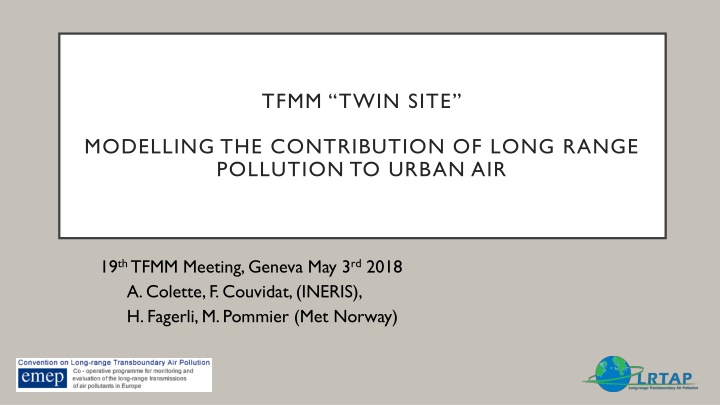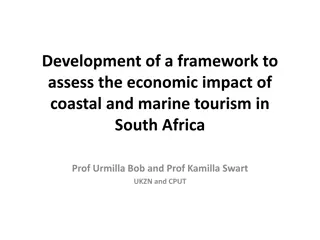
Modelling the Contribution of Long-Range Pollution to Urban Air Quality
Explore methodologies and observations for assessing the impact of long-range pollution on urban air quality. Comparison of chemical analyses and high-resolution CTM results at various urban and remote sites across Europe. Includes insights on PM10 and PM2.5 scatterplots, SIA scatterplots, and observations from different locations.
Download Presentation

Please find below an Image/Link to download the presentation.
The content on the website is provided AS IS for your information and personal use only. It may not be sold, licensed, or shared on other websites without obtaining consent from the author. If you encounter any issues during the download, it is possible that the publisher has removed the file from their server.
You are allowed to download the files provided on this website for personal or commercial use, subject to the condition that they are used lawfully. All files are the property of their respective owners.
The content on the website is provided AS IS for your information and personal use only. It may not be sold, licensed, or shared on other websites without obtaining consent from the author.
E N D
Presentation Transcript
TFMM TWIN SITE MODELLING THE CONTRIBUTION OF LONG RANGE POLLUTION TO URBAN AIR 19thTFMM Meeting, Geneva May 3rd2018 A. Colette, F. Couvidat, (INERIS), H. Fagerli, M. Pommier (Met Norway)
URBAN AND LONG RANGE AIR POLLUTION Methodologies available to assess the local/non-local contribution to urban air: Observations: Lenschow method and derivatives, applied to PMF or concentrations Integrated assessment models: GAINS and Sherpa source allocations Validating/Comparing models and observations the various available methodologies are not straightforward to compare Inconsistent definition of city masks compensation of city spread and city contribution We focus here on the (well posed) comparison of Chemical analyses of PM at pairs of urban/remote sites High resolution CTM results
OBSERVATIONS Available sites Spain: Barcelona (UB), Montseny (RB), Montsec (Mountain) Switzerland: Zurich-Kaserne (urban background), Payerne (rural). France: Revin (RB), Lens (UB), Roubaix (traffic). Germany: Leipzig (traffic-urban)/Melpitz (regional) Netherlands: Schiedam (urban ~Rotterdam) / Hellendoorn (rural) Chemical species Observed : PM10, PM2.5, Al, Ca , K, Na, Mg, Fe, Mn, Ti, V , Ni , Cu , As, Rb, Sr, Sb , Pb , SO42-, NO3-, Cl-, NH4+, EC, OC Subset for the comparison with models: SO42-, NO3-, NH4+, Dust, Sea Salt, OM, EC The remaining fraction is mainly water
CTM INVOLVED IN THE ANALYSIS High resolution CTM over the whole Europe Chimere Simulation (underlying Sherpa): 7km for 2009 with either INERIS or JRC inventory EMEP Emep MSCW 2017 Report (0.1x0.1 deg, 37 layers for 2015 with 2015 EMEP 0.1 emissions) Emep underlying Sherpa, (0.1x0.1 deg 20 layers) for 2014 with 2014 emissions (JRC) Chemical comparison Observations: SO42-, NO3-, NH4+, Dust, Sea Salt, OM, EC Chimere has SOA + PPM (roughly 30/70%), to be compared to OM+EC Emep is lacking Dust and Sea Salt in some outputs
PM10AND PM2.5SCATTERPLOTS Models included: EMEPr: MSCW Report EMEPs: Sherpa basecase CHIMERE: Sherpa basecase CHIMERE-JRC: Sherpa basecase, with JRC inventory Similar performances at most stations
SIA SCATTERPLOTS The main difference is for sulphates
INCREMENT: SWITZERLAND Large overestimation of PM10 increment due to other (=EC+OM), except for EMEP- Sherpa SO4 gradient well captured by all models All models except EMEP-Sherpa have an increase of NO3&NH4 in urban area which is not in the measurements
INCREMENT: THE NETHERLANDS Fairly good agreement for PM10 increment, except for EMEP-Sherpa that has a lower other increment, therefore a net decrement in PM10 Decrement of NH4NO3in urban area, well captured by all models
INCREMENT: FRANCE Strong overestimation of EC+OM increment for all models Good agreement for inorganics (especially for CHIMERE)
INCREMENT: SPAIN Chimere lacks coarse nitrate formation therefore the opposite urban nitrate increment Overestimate of OM+EC increment in all models
EC+OM INCREMENTS Scattered CTM performances across models for EC+OM gradients: + overestimate - underestimate Ok: good capture CHIM- Ineris + CHIM- JRC + EMEP-Report EMEP- Sherpa ok C H NL FR SP + ok + ok ok + + ok + + - + +
PM10URBAN INCREMENT Observed and modelled urban-rural gradients for PM10/PM25airbase sites of major European cities Urban: < 0.5 deg Background >0.5 and < 2 deg Only Chimere represented: The JRC inventory tends to overestimate the increment compared to the INERIS (EC4MACS) inventory
CONCLUSION Preliminary conclusions (work in progress) The CTMs capture well the gradients of SIA, except one instance of urban coarse nitrate (SP) Urban increment dominated by carbonaceous aerosols (EC+OM), except for NL where the decrement of NH4NO3 is substantial Scattered CTM performances across models for EC+OM gradients: Next steps Include more CTMs Scale dependency, alternative EMEP results Better handling of interannual variability

